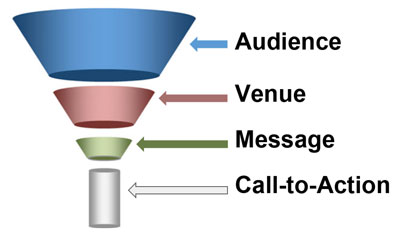Nonprofit videos are an incredible way to inspire and motivate, which is critical for organizations. I spent 7 years working in the Development Department of Maryland Public Television producing over 90-hours of live-television fundraising a year, and one of the most important things I learned was that people give their support for emotional reasons. For example, a nature program showing a baby elephant taking its first steps in life invoked emotions anyone could connect with.
So how do you apply it to your nonprofit? Think about approaching storytelling as though it’s a funnel.
The Communication Funnel

Audience Who are you talking to? What are the demographics? The clearer your audience is in your mind, the more successful you will be communicating with them.
Venue The venue is where you’ll find your audience online. How does your audience prefer to be communicated with? Your venue will help determine the tone of how you communicate. For example, Facebook is a more casual and personal venue than LinkedIn, which is primarily used for professional communication. Instagram is best used with an image and text, maybe as a tease that links to a longer message.
Message What message will resonate the most with your audience is a critical piece of the funnel. This is your opportunity to make a heartfelt connection with your audience.
Call-to-Action This is where the rubber meets the road. Asking your audience to support your organization financially or with an action is often not capitalized on. Make it easy for your audience to click on a link to donate, sign up, or make a difference. If you don’t ask, you won’t receive.
The Elements of Heartfelt Storytelling
The story is the Message and Call-to-Action parts of the Communication Funnel. Successful nonprofit stories are tightly crafted, even when they are not scripted word for word. I recommend scripting or story-boarding your video before you tape to ensure that you don’t miss any elements. Being prepared will enable you to take advantage of the emotional moments as they materialize. I typically divide the story into four parts:
• Hook (Tease) – This is where you grab your audience’s attention. Today’s online visitors need to be grabbed in seconds! Peak their interest as fast as you can.”
• Bait (Facts) – Here is your opportunity to Win Minds! Use content that supports your hook and answers a fundamental question like, “What makes your nonprofit different?”
• Bite (Emotion) – This it emotional part of the story, where you Win Hearts, and should conclude just before the call-to-action.
• Catch (Ask) – Time for the call-to-action! Make it clear and easy. “Go to our website to volunteer/support/know more” The emotion may not last, so you want to strike while the iron heart is hot!
CALL TO ACTION WAS HERE
“The Martin S. Lampner Technology & Innovation Fund” is our latest nonprofit video. It was shown at the Chimes October 2016 Gala to introduce the audience to the importance of technology in the lives of individuals with special needs. The Hook – retiring loved leader, Bait – technology fund, Bite – the difference technology makes in the lives of the folks Chimes serves, Catch – support Chimes now. What do you think?
TIP: I recommend using YouTube over other video platform because it’s the second largest Search Engine and is owned by Google. Make sure you maximize all of YouTube’s features including many keywords, linking with Google Maps, closed-captioning, and secondary languages (when it makes sense). VentureBeat lists YouTube among the largest social media sites, YouTube drives the most highly engaged website traffic (with visitors overall spending on average nearly four minutes and visiting three pages on target sites).
Summit Business Technologies has a long history of working with nonprofit organizations. Want to know more?






